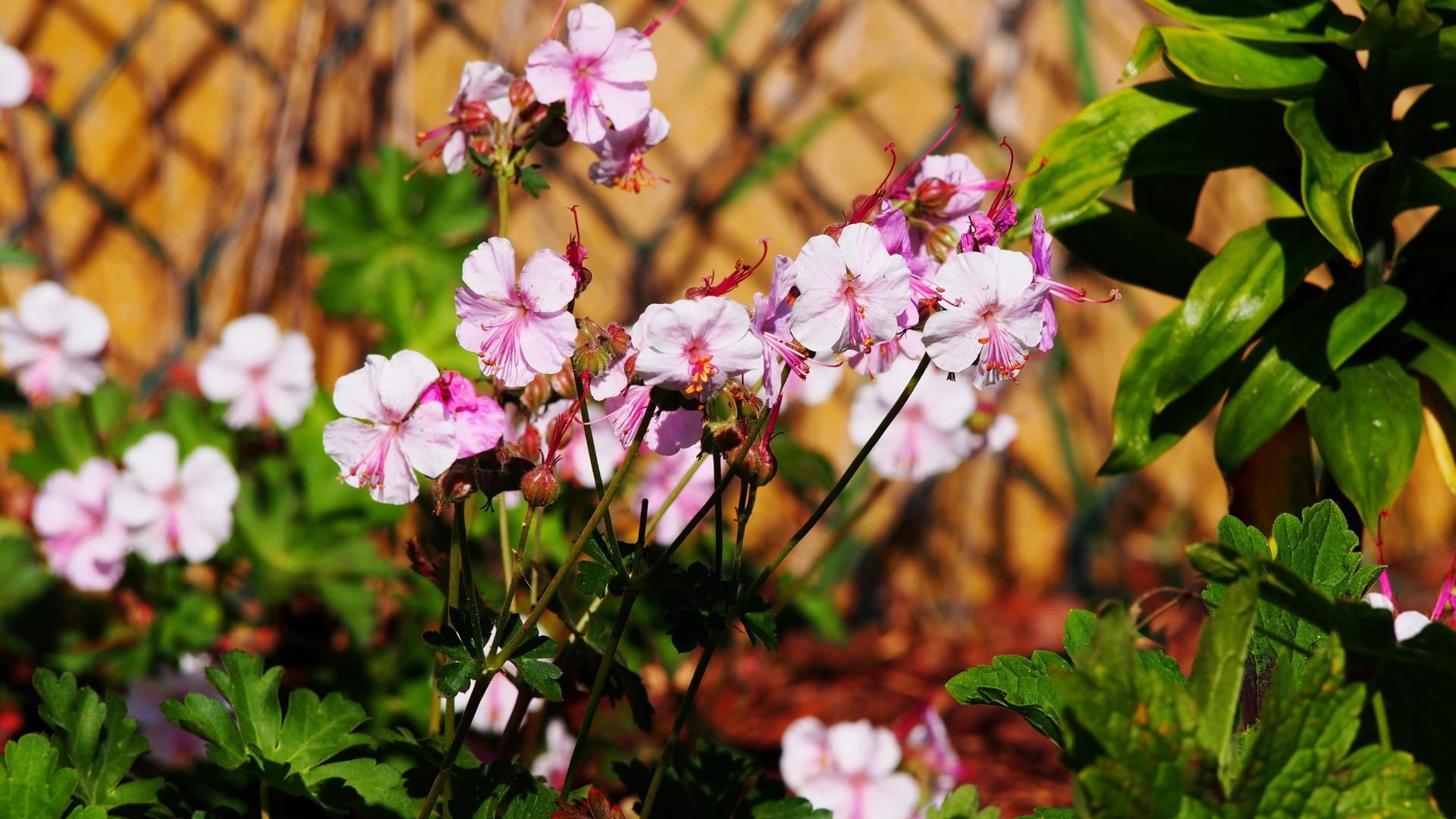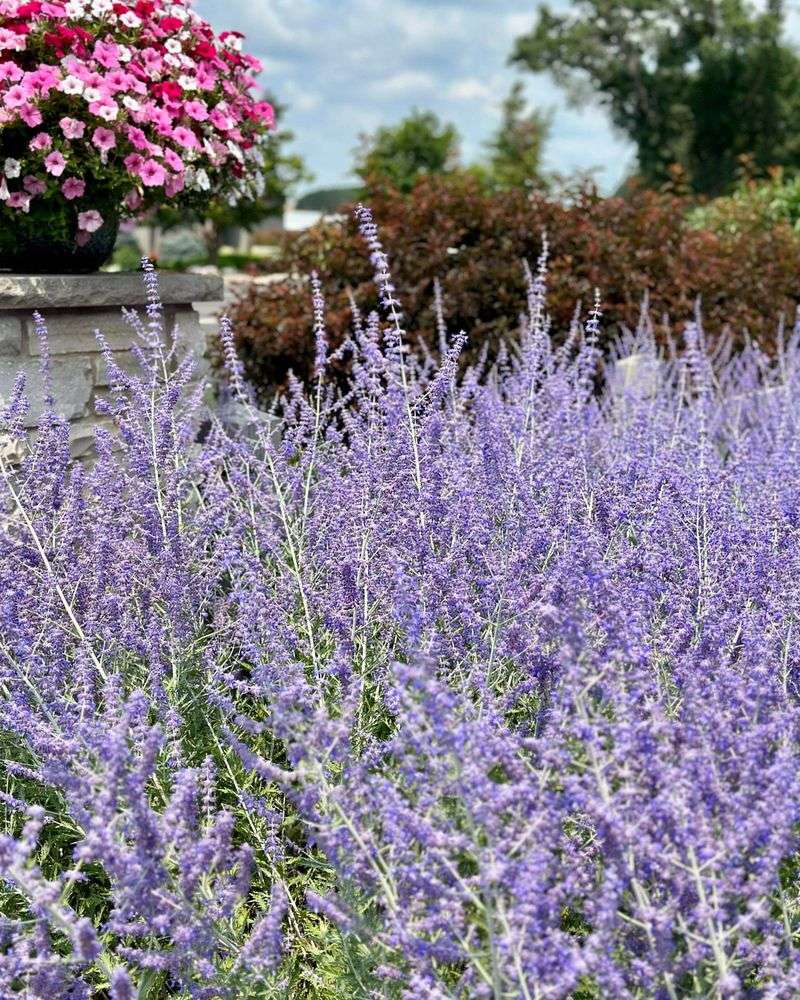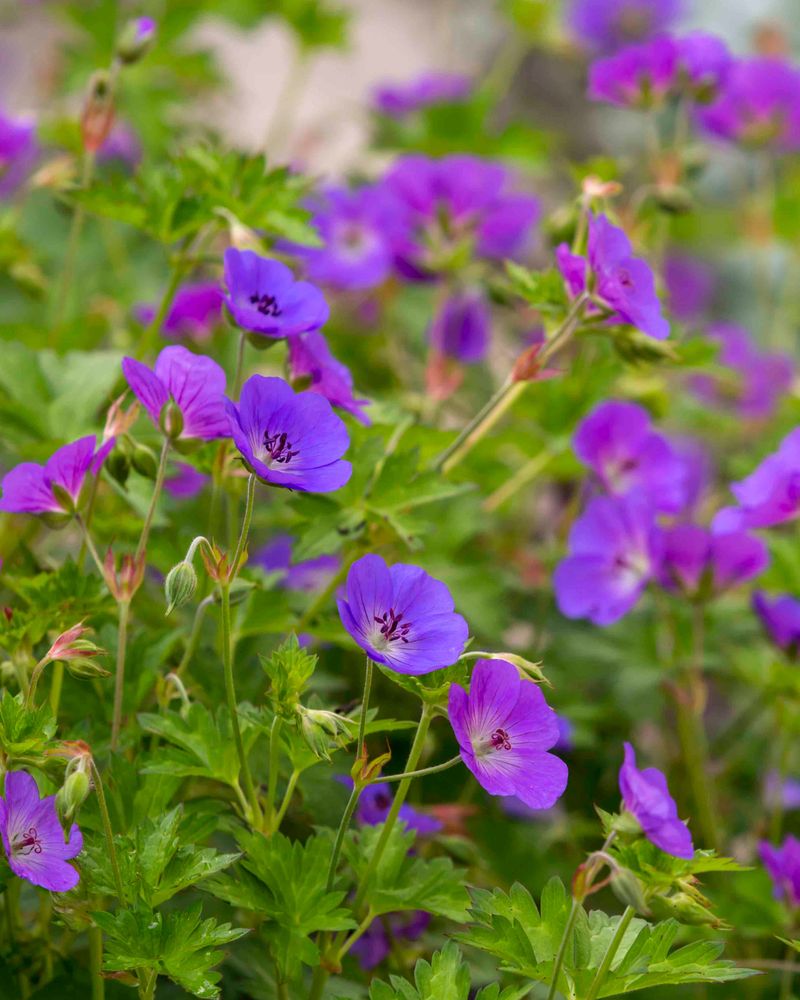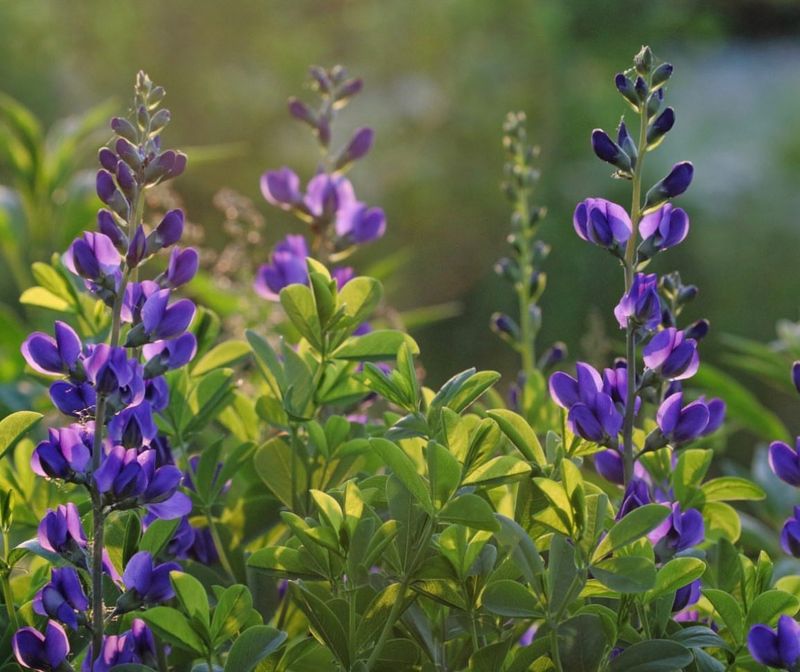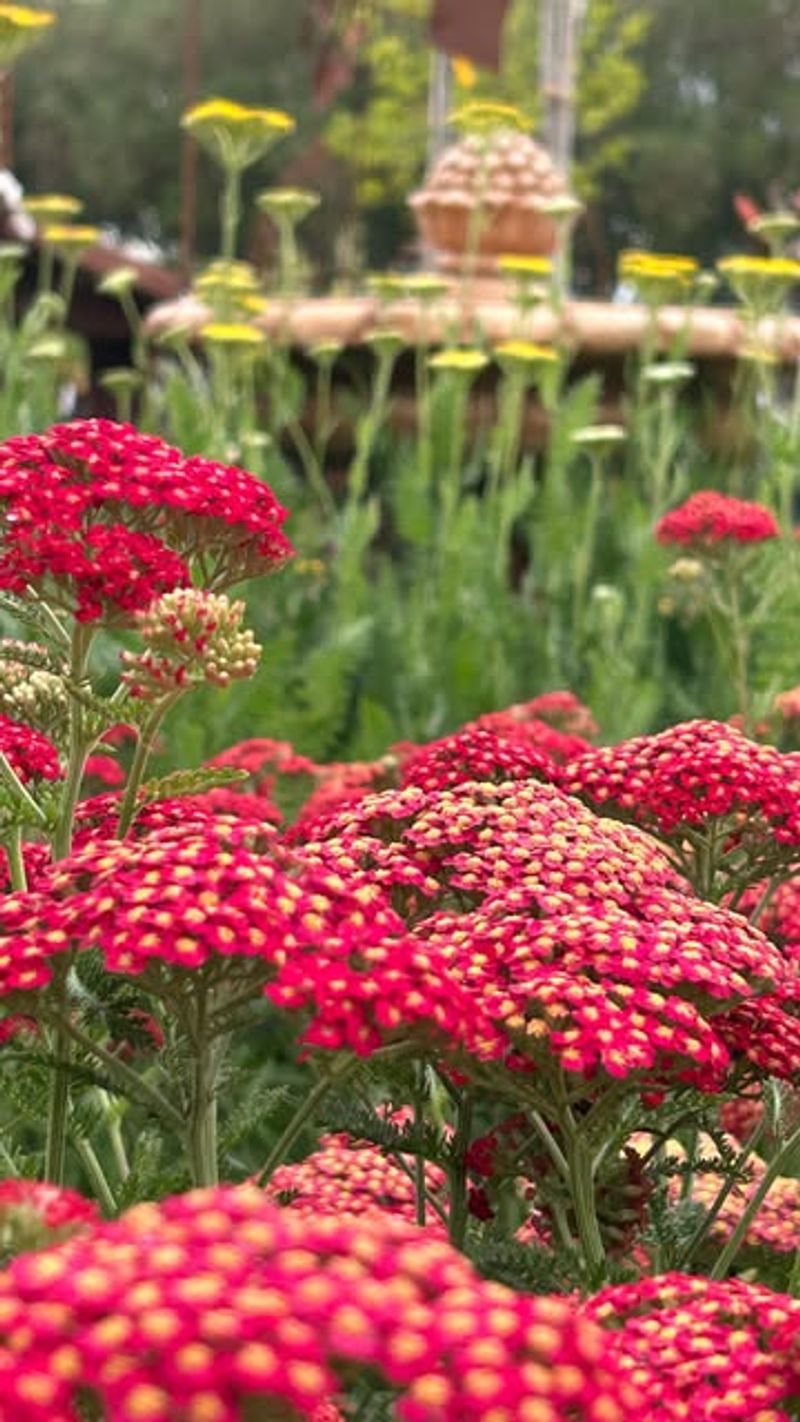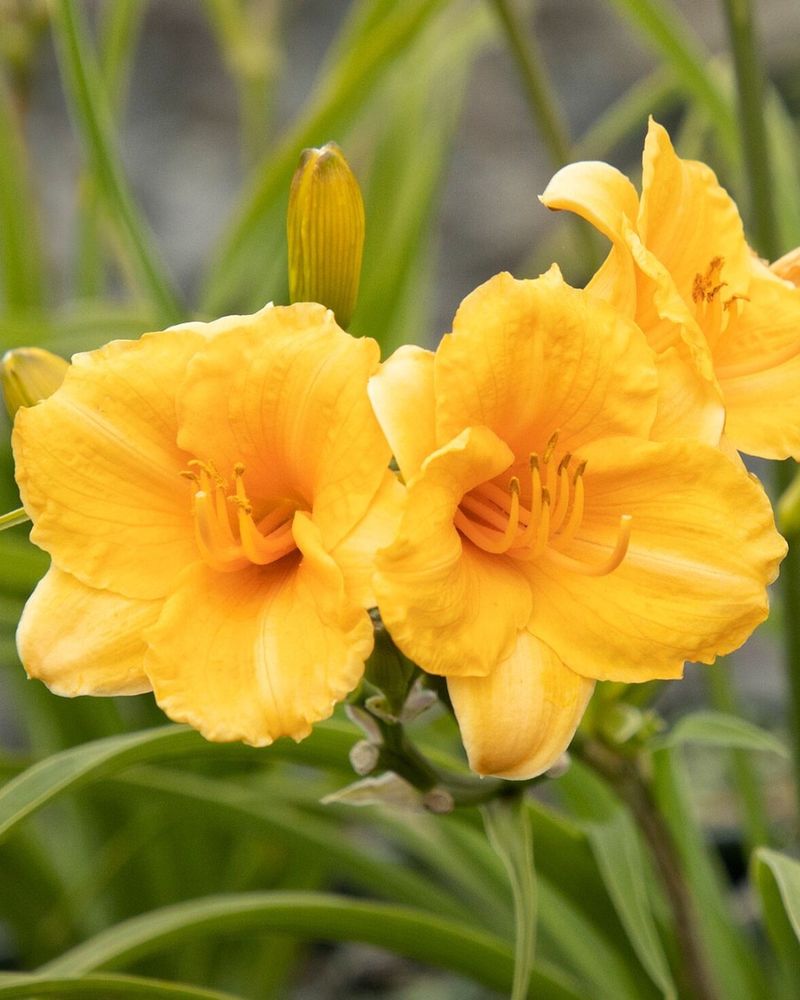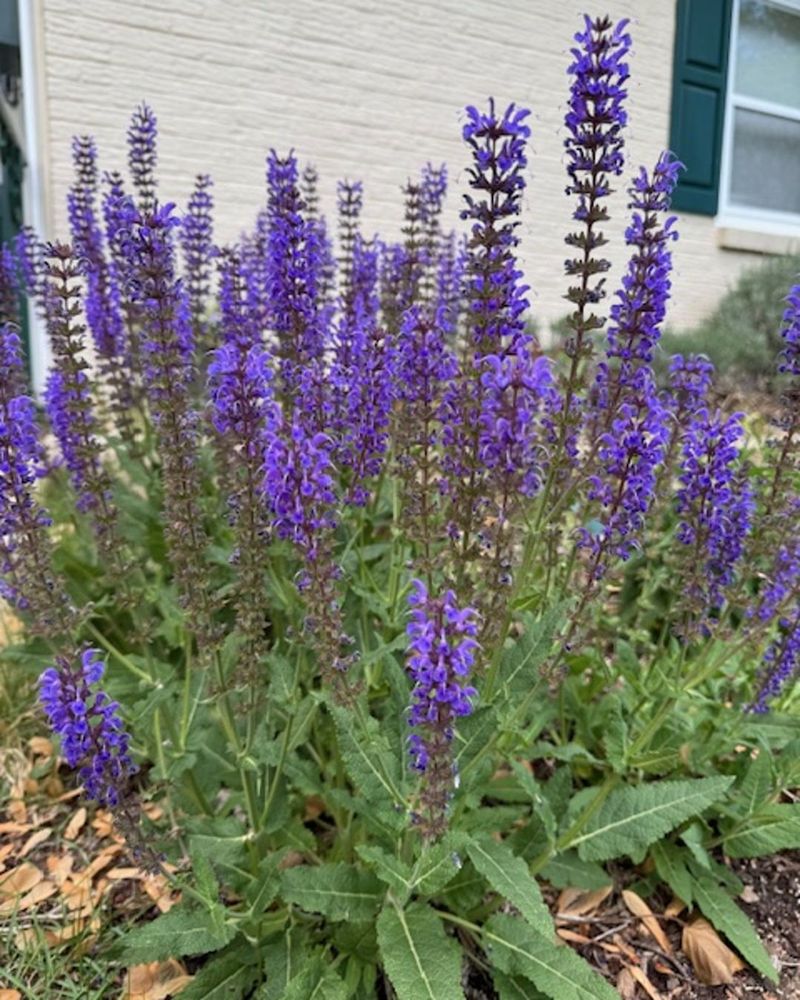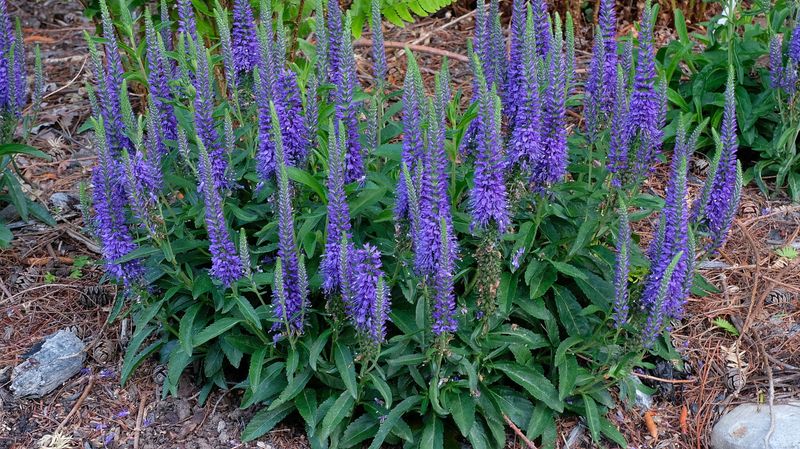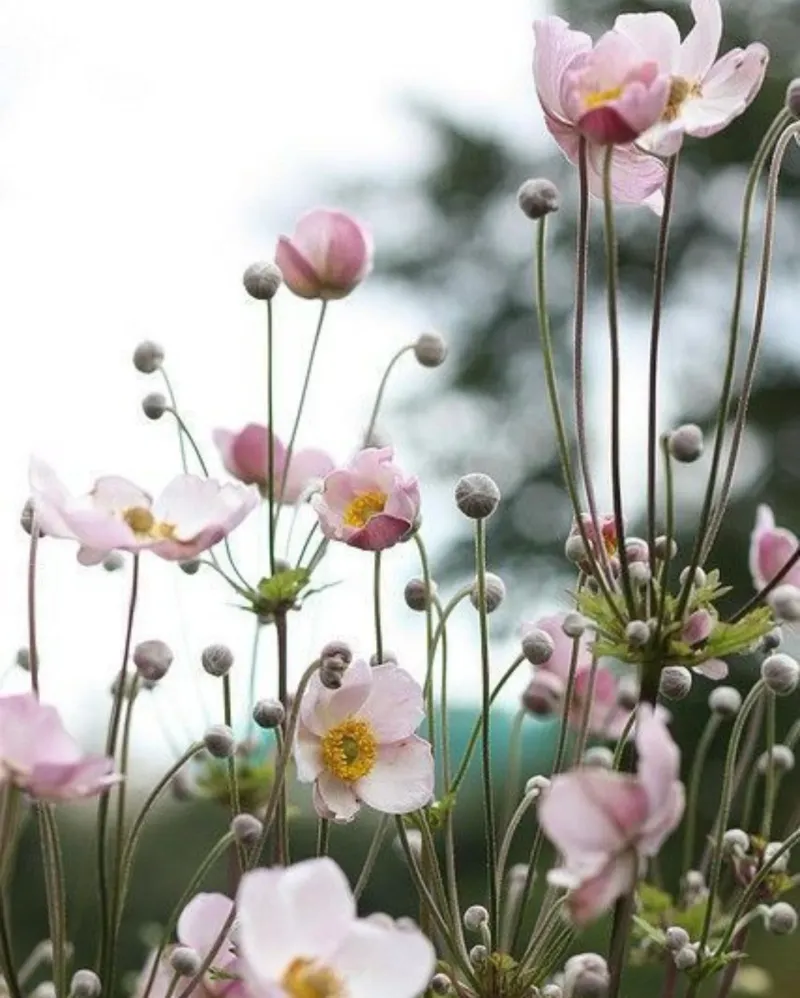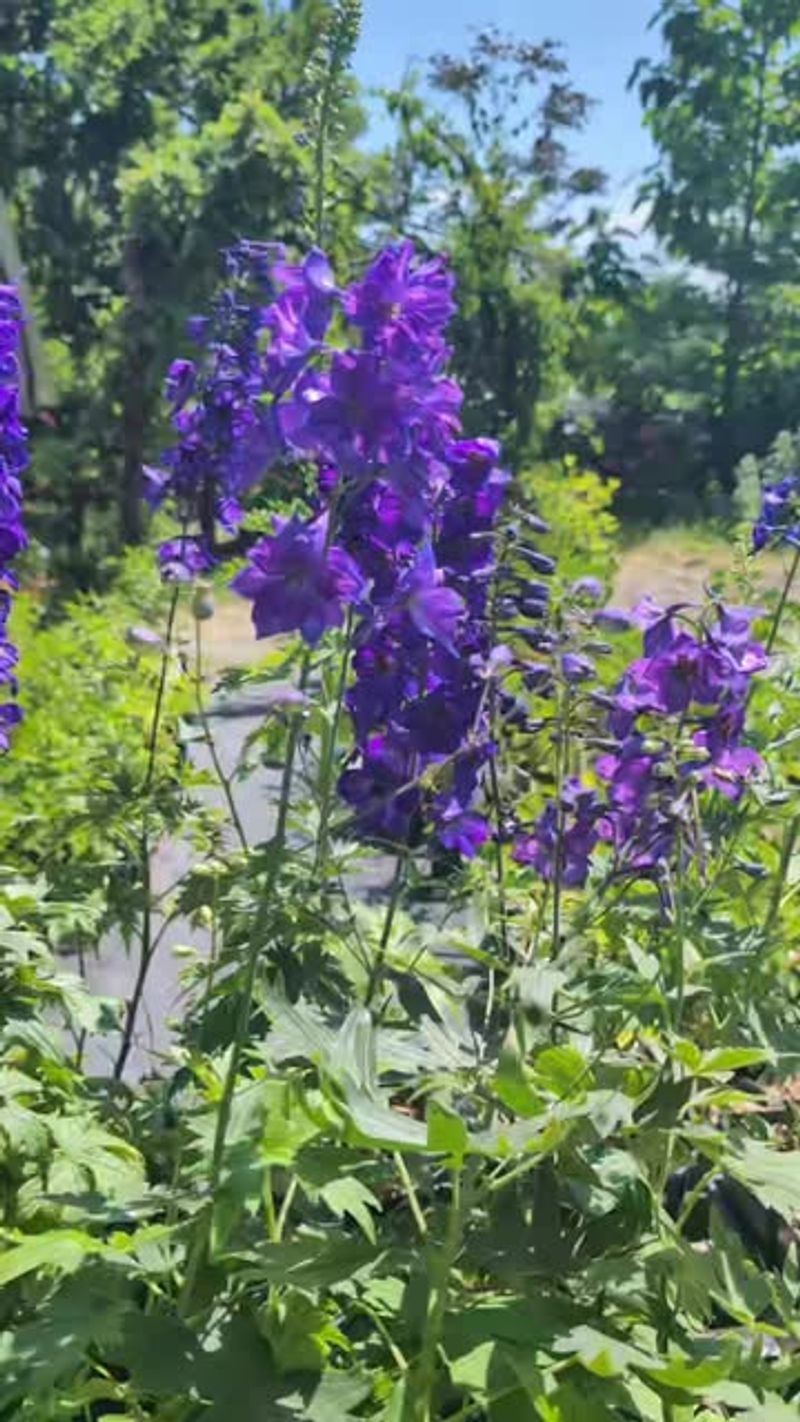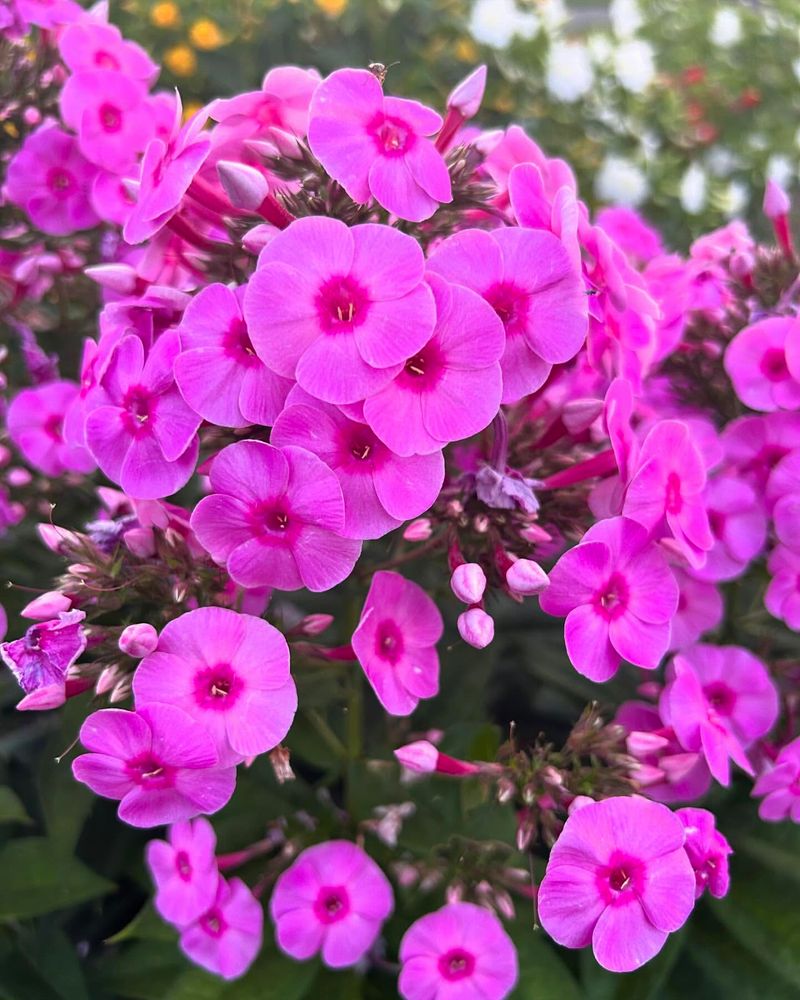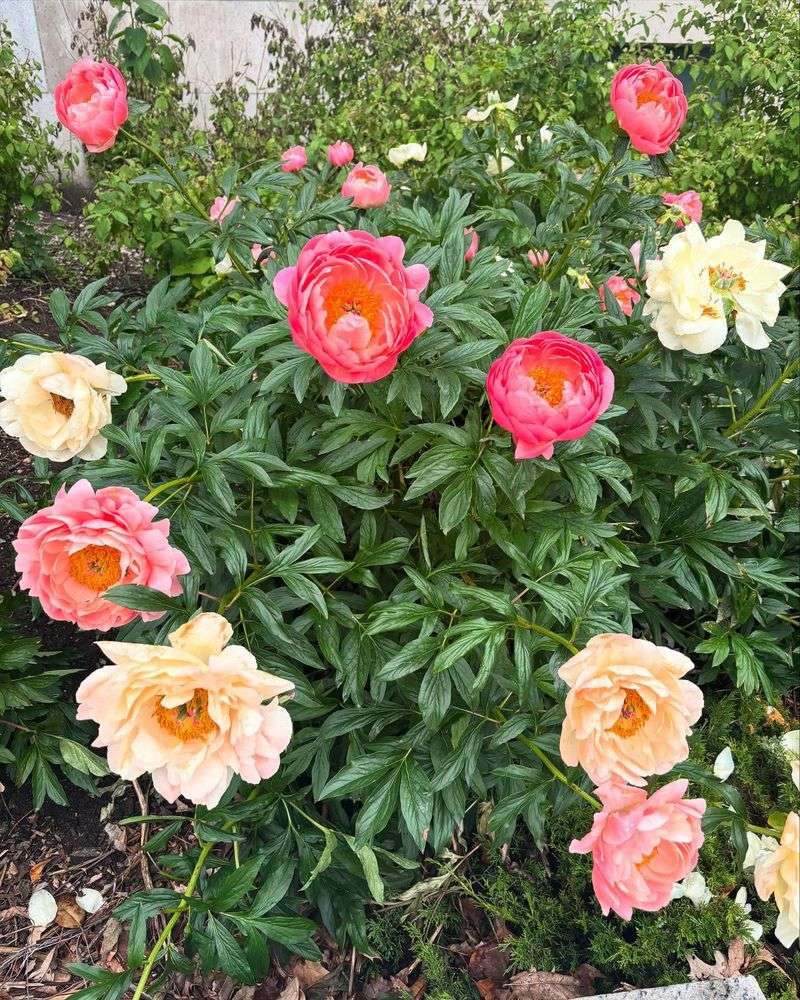Not every flower needs constant care to look its best. Some perennials just bloom and bloom—no snipping, no fuss. I’ve found that these long-lasting, low-maintenance plants are garden gold, especially during busy seasons.
If you love color without the constant upkeep, these 15 perennials are perfect. And for the few that do need a little extra love? I’ve included 5 that repay a quick trim with even more blooms.
1. Carefree Black-Eyed Susans
Sunshine incarnate in flower form, Black-Eyed Susans create a sea of golden petals around chocolate centers that pollinators can’t resist. These native wildflowers bloom from June through September without asking for a single snip.
Plant them in full sun with well-draining soil, and they’ll reward you year after year. Their drought tolerance makes them perfect for hot, sunny borders.
As a bonus, leaving the seedheads intact provides winter food for birds and creates natural reseeding for more flowers next season.
2. Resilient Russian Sage
Lavender-blue spires of Russian sage create a dreamy, cloud-like effect in the landscape from midsummer until frost. The silvery foliage adds texture even when not in bloom, complementing nearly any garden color scheme.
Remarkably drought-tolerant once established, this perennial thrives in poor soil where other plants struggle. Butterflies flock to its tiny flowers while deer and rabbits leave it alone.
For best results, plant in full sun and give it space—this beauty can reach 3-4 feet tall and wide.
3. Enduring Autumn Joy Sedum
Starting as broccoli-like clusters in summer, Autumn Joy Sedum’s flower heads gradually transform from pale green to pink and finally rich copper-red by fall. This color-changing act happens without any deadheading needed.
Succulent leaves store water, making this plant incredibly drought-resistant. The flat flower clusters provide perfect landing pads for butterflies and bees searching for late-season nectar.
Plant in full sun with well-draining soil, and watch this four-season performer work its magic. Even in winter, the dried flower heads add structure to the garden.
4. Vibrant Coreopsis
Nicknamed ‘tickseed’ for their small round seeds, coreopsis varieties offer non-stop blooming from early summer through fall. The daisy-like flowers in gold, yellow, pink, or bicolor patterns seem to smile at you from the garden.
Modern varieties like ‘Moonbeam’ and ‘Zagreb’ keep blooming without deadheading, though a mid-season trim can rejuvenate them for an even longer show. Their fine-textured foliage stays neat all season.
Adaptable to various soil types and resistant to deer browsing, coreopsis deserves a spot in every low-maintenance garden.
5. Steadfast Catmint
Waves of lavender-blue flowers dance above aromatic gray-green foliage from late spring through summer. Nepeta (catmint) varieties like ‘Walker’s Low’ and ‘Purrsian Blue’ bloom continuously without deadheading, though a quick shearing after the first flush can trigger an even more impressive second show.
Bees buzz happily among the blossoms while cats may roll contentedly in the foliage. The minty scent repels many garden pests naturally.
Drought-tolerant and deer-resistant, catmint thrives in full sun to light shade, forming tidy mounds that soften garden edges beautifully.
6. Effortless Echinacea
Purple coneflowers stand tall and proud through summer heat, their rosy-purple petals surrounding prominent orange-copper cones. Native to American prairies, these tough perennials bloom for months without any deadheading required.
Butterflies, bees, and goldfinches adore echinacea—the birds especially love the seeds that develop in the cones. The deep taproots make these flowers remarkably drought-resistant once established.
Modern varieties expand the color palette to include white, yellow, orange, and even green blooms, all with the same carefree nature.
7. Persistent Perennial Geraniums
Not to be confused with annual geraniums, these hardy perennials (also called cranesbills) produce masses of saucer-shaped flowers in shades of purple, pink, blue, and white. Varieties like Geranium ‘Rozanne’ bloom from early summer until frost without deadheading.
The deeply cut foliage often takes on beautiful fall colors, extending seasonal interest. Most varieties form neat mounds that suppress weeds naturally.
Adaptable to sun or partial shade, perennial geraniums work beautifully as ground covers, border plants, or rock garden specimens. They’re also remarkably resistant to rabbits and deer.
8. Faithful Lamb’s Ear
Velvety silver leaves that beg to be touched are the main attraction of lamb’s ear, but the tall purple flower spikes that appear in summer provide bonus interest. The fuzzy foliage naturally repels deer and rabbits—they dislike the texture.
Some varieties, like ‘Silver Carpet,’ rarely flower and focus on foliage instead. Others, including ‘Big Ears,’ produce dramatic flower stalks that don’t require deadheading.
Plant in full sun with well-draining soil to prevent rot in humid conditions. The silvery color brightens shady spots and complements any flower color in the garden.
9. Unstoppable Baptisia
False indigo creates a shrub-like presence in the garden, with blue-green foliage topped by spires of lupine-like flowers in late spring. After the initial bloom show, attractive seed pods develop that rattle delightfully in the breeze.
Modern hybrids offer colors beyond the traditional blue, including yellow, white, purple, and pink. The deep roots make baptisia extremely drought-tolerant once established.
Plant in full sun and be patient—this long-lived perennial takes a few years to reach its full potential but rewards patience with decades of carefree performance.
10. Abundant Yarrow
Flat-topped flower clusters in shades of yellow, white, pink, or red hover above ferny, aromatic foliage from early summer through fall. Yarrow’s flowers dry naturally on the stem, maintaining their color and structure without deadheading.
Ancient herb gardens valued yarrow for its medicinal properties. Today, we appreciate its drought tolerance and ability to thrive in poor soil where other plants fail.
Butterflies flock to the flowers while deer and rabbits avoid the bitter foliage. For best results, plant yarrow in full sun and divide every few years to maintain vigor.
11. Dependable Daylilies
Often called the perfect perennial, daylilies produce trumpet-shaped blooms in nearly every color except true blue. While each individual flower lasts just one day (hence the name), plants produce dozens of buds on each stem for weeks of continuous color.
Reblooming varieties like ‘Stella de Oro’ and ‘Happy Returns’ flower from early summer until frost without deadheading. Their strappy foliage remains attractive all season, rarely troubled by pests or diseases.
Plant in full sun to light shade in almost any soil type. These adaptable perennials perform beautifully in both formal gardens and naturalized settings.
12. Steadfast Salvia
Spikes of intense blue, purple, or pink flowers rise above aromatic foliage, creating vertical accents in the garden from late spring through summer. Perennial salvias like ‘May Night’ and ‘Caradonna’ bloom profusely without deadheading.
Hummingbirds and butterflies can’t resist the nectar-rich flowers, while deer and rabbits avoid the scented foliage. The square stems identify these plants as members of the mint family.
For best performance, plant salvias in full sun with well-draining soil. Their drought tolerance makes them perfect for hot, sunny spots where other perennials might struggle.
13. Reliable Veronica
Spiky flower clusters in shades of blue, purple, pink, or white create vertical interest in the garden from early summer through fall. Speedwell (Veronica) varieties like ‘Sunny Border Blue’ and ‘First Love’ bloom continuously without deadheading.
Butterflies and bees flock to the nectar-rich flowers while the compact growth habit makes these plants perfect for front-of-border placements. The glossy foliage stays attractive all season.
Plant in full sun to partial shade in moderately moist, well-draining soil. Veronicas combine beautifully with daylilies, coreopsis, and other summer bloomers.
14. Relaxed Lavender
Fragrant purple flower spikes rise above silvery foliage, creating a sensory delight in the garden from early to midsummer. The blooms dry naturally on the plant, maintaining their color and scent without deadheading.
English lavender varieties like ‘Hidcote’ and ‘Munstead’ are the most cold-hardy options for northern gardens. French and Spanish types offer larger flowers in warmer climates.
Plant in full sun with extremely well-draining soil—lavender hates wet feet. The aromatic foliage repels deer and rabbits while attracting bees and butterflies to its nectar-rich flowers.
15. Tranquil Japanese Anemone
Elegant pink or white poppy-like flowers dance on tall, wiry stems above dark green foliage from late summer through fall. These late-season bloomers take over when many other perennials have finished their show.
Japanese anemones gradually form colonies through underground runners, creating beautiful drifts of color. Their late blooming provides crucial nectar for pollinators preparing for winter.
Plant in partial shade with consistently moist, rich soil. Unlike many plants on this list, anemones prefer protection from hot afternoon sun and need regular water during dry spells.
16. Demanding Delphinium
Soaring spires of blue, purple, pink, or white flowers create unmatched vertical drama in early summer gardens. These cottage garden classics need deadheading after their initial bloom to encourage a second, smaller flush of flowers in fall.
The effort pays off with their incomparable height and color intensity—true blues that few other flowers can match. Staking helps support the tall stems, which can reach 6 feet in ideal conditions.
Plant in full sun (with afternoon shade in hot climates) and rich, moist, well-draining soil. Protection from strong winds helps prevent toppling.
17. High-Maintenance Hollyhocks
Towering flower stalks covered with rosette-like blooms in nearly every color create old-fashioned charm from midsummer through early fall. Though technically short-lived perennials, hollyhocks need deadheading to prevent excessive self-seeding and extend blooming.
Regular removal of lower leaves affected by rust helps maintain plant appearance. The extra effort rewards you with dramatic 6-8 foot flower spikes that create instant vertical impact.
Plant in full sun with well-draining soil against walls or fences that provide wind protection. Allowing some seedheads to remain ensures new plants for future years.
18. Particular Phlox
Fragrant dome-shaped flower clusters in white, pink, purple, or bicolor patterns brighten the mid-to-late summer garden. Garden phlox benefits significantly from deadheading spent blooms, which prevents self-seeding and encourages additional flowering.
Regular deadheading also helps reduce powdery mildew problems by improving air circulation. The sweet fragrance attracts butterflies and hummingbirds while the sturdy stems rarely need staking.
Plant in full sun (with afternoon shade in hot climates) and rich, moist soil. Good air circulation helps prevent disease issues common to these otherwise rewarding perennials.
19. Particular Peonies
Lush, often fragrant blooms in shades of pink, red, white, or yellow create unmatched early summer splendor. While peonies bloom reliably without intervention, deadheading spent flowers prevents seed formation and directs energy back to the roots for next year’s display.
The extra effort keeps plants looking tidy and prevents flopping from heavy seedheads. Some gardeners leave a few seedpods for ornamental interest—they split open to reveal glossy black and red seeds.
Plant in full sun with rich, well-draining soil, being careful not to bury the eyes (growth buds) more than 2 inches deep.
20. Fussy Foxgloves
Bell-shaped flowers arranged on tall spires create vertical drama in partially shaded gardens from late spring through early summer. Though technically biennials or short-lived perennials, foxgloves will bloom longer with regular deadheading.
Removing spent flower stalks encourages side shoots to develop and bloom. Leave some stalks to form seed for natural reseeding if you want these enchanting plants to return year after year.
Plant in partial shade with rich, moist, well-draining soil. The spotted throat markings inside the flowers guide bees to the nectar, creating nature’s perfect pollinator pathway.

